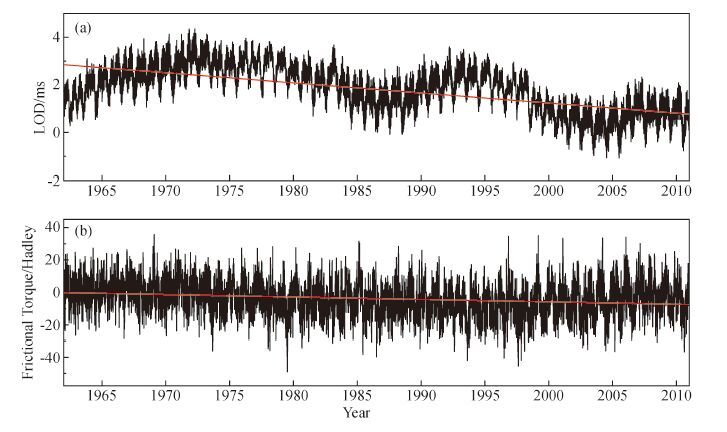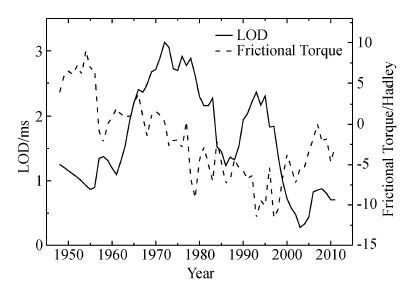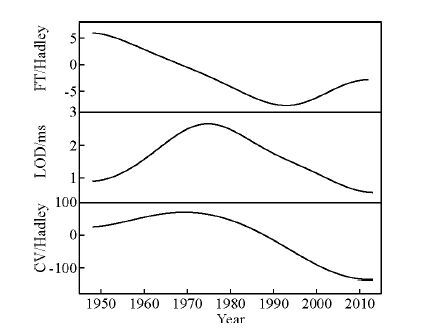2. 中国科学院地理科学与资源研究所, 生态系统网络观测与模拟重点实验室, 北京 100101
3. 中国气象局, 国家卫星气象中心, 北京 100081
2. Key Laboratory of Ecosystem Network Observation and Modeling, Institute of Geographic Sciences and Natural Resources Research, Chinese Academy of Sciences, Beijing 100101, China
3. China Meteorological Administration, National Satellite Meteorological Center, Beijing 100081, China
固体地球角动量和地球自转速度的变化可以用日长(LOD)来表征.日长指的是地球自转一周,即一昼夜所用的时间和原子钟所计量的规定的一天时长之间的差值.由于地球自转的变化与固体地球、海洋和大气变化息息相关,在地球系统总的角动量守恒的前提下,固体地球角动量减少,其他部分角动量必定会增加.因此日长的变化与大气角动量(AAM)的改变具有很高的相关性,二者之间存在必然的联系(Oort,1989).许多学者已经对两者之间的关系进行了研究(Rosen and Salstein,1985,1991; 顾震年,1994,1996;Oort,1989;Zheng et al.,2003;Yang et al.,2014),并给出了大气角动量与日长变化之间的定量关系(Langley et al.,1981;杨志根,1994).目前学者们基本接受,在十年以上时间尺度的地球自转速度变化主要取决于地核和地幔之间的角动量交换(Hide and Dickey,1991; Pais and Hulot,2000),日长在两年内的波动变化主要是由于大气波动变化引起(Lambeck and Cazenave,1976),同时受太阳辐射光压变化影响(宋贯一等,2007;宋贯一,2014).即在短时间尺度上大气变化驱动地球自转变化,在长时间尺度上地球核幔耦合改变驱动大气圈和水圈变化(Duhau,2006).
直接对比研究日长和大气角动量的关系,无法从机理上解释地球和大气相互作用的过程.摩擦力矩和山脉力矩作为大气与地球之间角动量交换的两种重要途径,越来越受到研究者的关注.摩擦力矩是指由于大气运动和地球自转速度不一致,使大气和地球表面相互摩擦而形成的轴向转动力矩.山脉力矩是指在地球起伏表面的东西两侧,由于地表面气压不同而产生的转动力矩(Weickmann and Sardeshmukh,1994; Driscoll,2010).地球和大气之间通过山脉力矩和摩擦力矩的作用进行轴向角动量传输,其变化对地球大气系统具有重要的影响作用.前人在研究摩擦力矩与山脉力矩与大气角动量、天气尺度系统的关系方面做了大量工作(Rosen,1993;Weickmann and Sardeshmukh,1994; Madden and Speth,1995;Weickmann et al.,1997; Weickmann,2003;王亚非等,2011;石文静等,2014).近年来,也开始有学者关注山脉力矩的时空变化及其与日长之间的年际变化关系(朱琳等,2014),但针对摩擦力矩与日长的关系方面的研究还鲜有报道.研究摩擦力矩与日长的关系可以从机理上了解固体地球与大气之间角动量传输状态及其变化,对进一步揭示固体地球和大气之间的关系以及地球大气耦合研究具有重要意义.鉴于此,本文在前人研究的基础上,利用NCEP/NCAR再分析数据,计算出1948-2011年全球摩擦力矩,并利用滤波和平均的方法,对不同时间尺度上的日长与摩擦力矩间的关系进行了研究,从机理上探讨地球与大气角动量传输的状况,为进一步的固体地球与大气相互作用研究提供参考.
1 数据与方法 1.1 使用的数据全球摩擦力矩的计算参数数据来源于National Centers for Environmental Prediction-National Center for Atmospheric Research(NCEP/NCAR)第一套再分析资料,时间分辨率是1天,空间分辨率是192×94高斯格点,时间跨度为1948-2011年.
日长资料是从国际地球自转服务网站(http://www.iers.org/)得到的,从1962年1月至2010年12月一天间隔的日长资料序列和1623年至2010年日长年均值数据.
1.2 计算公式和分析方法全球积分形式的摩擦力矩计算公式为(Weickmann and Sardeshmukh,1994; Huang et al.,1999)

|
(1) |
其中a为地球半径,τ为地表应力,λ为经度,φ为纬度.对于全球积分的摩擦力矩结果,本文采用统一的单位Hadley(1Hadley=1.0×1018 kgm2s-2).文中没有特别说明的力矩都为全球积分结果.
2 摩擦力矩和日长在不同时间尺度上的关系 2.1 日变化本文计算出了摩擦力矩和日长1962到2010年的日平均值时间序列(图 1),在这一时间段内,日长变动最大值约为4.36 ms,最小值为-1.07 ms,平均约1.8 ms,标准差为0.97,整体呈下降趋势,通过线性拟合分析发现,其变率约为-1.2×10-4 ms/day(R2=0.39,P<0.01).摩擦力矩在这一时间段内的变化在-49.03 Hadley到35.73 Hadley之间,平均值约为-3.8 Hadley,与日长类似,整体也是呈现下降趋势,平均每天改变约为-4.1×10-4 Hadley(R2=0.038,P<0.01).日长与摩擦力矩的直接相关系数为0.13(P<0.01),通过显著相关检验,二者具有显著相关性.

|
图 1 摩擦力矩与日长变化(日值) Figure 1 Changes of Frictional Torque and LOD(Daily value) |
利用小波功率谱分析,发现摩擦力矩与日长都具有十分明显的半年和周年变化(表 1,图 2).日长半年和周年变化周期分别为182.6天和365.2天,与郭金运和韩延本(2008)利用1993-2006年日长数据计算半年和周年变化周期结果182.5天和362.7天基本一致.摩擦力矩半年和周年周期分别为182.9天和365.9天,和日长周期基本相同.并且在振幅上,二者的周年振幅都大于半年振幅.在更高的频段上,由于潮汐和月球引力的作用,日长具有明显的13.7天和27.5天的半月与月周期,半月周期振幅大于月周期.摩擦力矩的半月周期并不明显,但具有和热带Madden-Julian振荡相同的50天左右周期.
|
|
表 1 日长与摩擦力矩周期 Table 1 Periods of LOD and Frictional Torque |

|
图 2 日长与摩擦力矩的小波功率谱分析 Figure 2 Power spectrum analysis for LOD and Frictional Torque |
在季节尺度上,日长具有明显的40~50天振荡(廖德春和郑大伟,1996),和Madden-Julian振荡周期相同.图 3为计算出的1962-2010年平均的摩擦力矩和日长月值,二者的季节变化基本相同,都是在4月份达到一年中的最大值,4到7月之间,数值不断减弱,摩擦力矩在8月份左右达到最小值,而日长在达到最小值的时间上要比摩擦力矩早1个月,在7月左右达到最小.在8月到10月期间,二者数值迅速增大.日长1月和7月相差1ms左右,摩擦力矩1月和7月之间相差7 Hadley左右.地球自转速度在夏季快,在冬季较慢,和大气旋转速度变化的情况一致.而且在这一时间尺度上,日长和大气角动量也具有明显的相关性,具有相同的变化规律(Oort,1989).国内外学者研究结果也发现在周年周期上,风速变化和气压分布已经能基本解释在这一时间尺度上的日长改变.大气活动对地球自转速度变化的激励在这一时间尺度上起主要作用.

|
图 3 摩擦力矩与日长多年平均的12个月变化 Figure 3 Yearly average of Frictional Torque and LOD in 12 months |
在季节尺度上,地球自转变化和大气角动量的变化息息相关,而日长与摩擦力矩具有明显的相关性,说明地球与大气的角动量传输在这一时间尺度上主要通过摩擦力矩完成.更进一步证实了日长变化的原因在年内尺度是由于地球、大气、海洋系统间的角动量传输引起的,也说明了大气活动对固体地球自转速度的影响在年内时间尺度上最为显著.
2.3 年际变化图 4为日长和全球摩擦力矩积分的年平均值波动状况,从图中可以发现,日长在近60年内出现了两个峰值,分别出现在1972年和1993年.在1948年到2010年时间段内,日长平均值为1.62 ms,标准偏差为0.78,变化范围在0.27 ms到3.13 ms之间.通过线性拟合分析发现,在1972年以前,日长呈上升趋势,平均每年变化约0.09 ms(R2=0.77,P<0.01),在1972年以后,日长呈明显的下降趋势,平均每年变化约-0.06 ms(R2=0.74,P<0.01),总体主要呈现下降趋势,平均每年变化约-0.01 ms(R2=0.04,P<0.05),也代表了地球在这段时间内的自转速度在不断加快.廖德春和郑大伟(1996)研究发现,日长年际变化与大气准两年振荡、纬向风变化、ENSO等气候现象具有紧密的联系.摩擦力矩在1948到2010年间,其平均值为-2.06 Hadley,标准偏差为4.94,变化范围在-11.64 Hadley到9.05 Hadley之间.通过线性拟合分析发现,摩擦力矩在研究时间段内整体呈下降趋势,平均每年变化约-0.2 Hadley(R2=0.54,P<0.01),在1956年和1977年后,摩擦力矩出现较大幅度的降低现象,在1995年左右,摩擦力矩由下降的趋势转变为上升的趋势.

|
图 4 摩擦力矩与日长的年际变化 Figure 4 Interannual variations of Frictional Torque and LOD |
在年际变化尺度上,日长与大气角动量具有很高的相关性,相关系数达到了0.9,而且和厄尔尼诺,南方涛动指数也具有相当高的相关性,相关系数达到0.5~0.7,最大相关时,南方涛动指数约超前2个月(Zheng et al.,2003).作为大气与地球角动量传输途径之一,摩擦力矩年平均值与日长年平均值在研究时间段内,相关系数为-0.14(P=0.23),相关置信度较低.摩擦力矩滞后17年时与日长达到最大相关,相关系数为0.64(P<0.01),二者相关性显著.由此可以看出,摩擦力矩在年际尺度上并不能完全的体现出日长的变化规律,这一结果产生的原因可能是由于地球大气角动量在这一时间尺度上交换的过程中,并没有完全通过摩擦力矩来完成,力矩对大气地球角动量传输的相对重要程度在不同的时间尺度上是不同的,在年际尺度上山脉力矩可能在这一过程中起了主要作用.Swinbank(1985)通过计算全球摩擦力矩和山脉力矩也发现,在年际尺度上,山脉力矩对全球角动量变化更为重要,摩擦力矩次要,因此对日长改变的贡献很小,与本文结论相一致.在此时间尺度上,潮汐作用对日长改变的贡献也十分显著,在以上原因作用下,使得在这一时间尺度上摩擦力矩无法体现日长变化.
2.4 年代际变化日长十年尺度以上的周期主要是30年和60年,振幅为0.5 ms和1 ms左右(顾震年,1999),根据学者已有研究和化石推算,在近代日长的长期变化约为1.72 ms/cy,在更加久远的年代,日长的长期变化约为2.28 ms/cy,比现如今变化剧烈的多(尹赞勋和骆金锭,1976; 廖德春和郑大伟,1996).在本文研究时段内,日长还具有明显的准22年周期,而在摩擦力矩中并没有体现出这一周期.
为了更清楚的比较摩擦力矩与日长的年代际变化,本文对1948-2010年间全球摩擦力矩积分序列和日长时间序列利用10年滑动平均法,去除掉年代际以下时间尺度的波动,得到二者年代际变化曲线(图 5).研究时段内,全球摩擦力矩积分只有一个波谷,出现在20世纪90年代.从整体上看,摩擦力矩是一直在减少,直到90年代以后才开始增加.日长有一个波峰,位于20世纪70年代.在70年代初呈上升趋势,70年代中后期是下降趋势.在0滞后的时候摩擦力矩和日长具有负的相关性,相关系数为-1.3(P=0.3),不显著相关.在摩擦力矩滞后大约17年时与日长达到最高负相关,相关系数约为0.82(P<0.01),二者显著相关.从摩擦力矩的符号来看,1970年以后全球摩擦力矩积分值都是负值.由于摩擦力矩为正值时,地球将向大气传输角动量,大气角动量增加.摩擦力矩为负值时,大气将向地球传输角动量,地球本身角动量会不断的增加.全球摩擦力矩总的作用是使得大气至1970年后不断的通过摩擦力矩向地球传输角动量.地球得到角动量后,自转速度将会加快,日长将会减少.20世纪70年代中后期日长的减少与摩擦力矩的变化是一致的.

|
图 5 摩擦力矩(FT)、日长(LOD)及其累积值(CV)的年代际变化 Figure 5 Decadal fluctuations of Frictional Torque,LOD and Cumulate Value of Frictional Torque |
为了进一步验证日长与摩擦力矩的关系,对10年滑动平均的全球摩擦力矩时间序列计算了累积值并与10滑动平均的日长进行了对比(图 5).结果发现,日长年代际变化与摩擦力矩累积值的波峰很接近,二者相关系数为0.74(P<0.01),二者显著相关,当累积值滞后2年时与日长达到最大相关,相关系数约为0.75(P<0.01).
在以往的研究中,大气角动量的变化无法解释地球自转十年尺度以上的波动.本文通过摩擦力矩与日长年代际的变化规律表明,在年代际时间尺度上,地球自转的变化不仅来自地核、地幔角动量的传输,大气与地球之间相互作用的长时间累积也起到了重要的作用.
3 结 论3.1 摩擦力矩作为大气角动量的一部分,通过研究摩擦力矩与日长在各个时间尺度上的变化,可以了解大气与固体地球之间相互作用的具体途径和过程,为进一步认识日长变化与大气和气候变化之间的关系具有重要意义.本文通过滤波和平均的方法,对摩擦力矩和日长在不同时间尺度上的变化进行了分解分析.
3.2 通过本文研究可以发现:
(1) 在年代际尺度上,地球自转变化与摩擦力矩的累积具有相似的变化,说明在长时间尺度上大气与固体地球之间的相互作用的长时间累积,对地球自转速度也有重要影响.
(2) 在年际尺度上,年代际尺度一下,摩擦力矩与日长变化的相关性较低,相关系数为-0.14,这说明在这一时间尺度内,地球大气的角动量交换并不仅仅只通过摩擦力矩来实现,摩擦力矩的变化并不能完全体现出地球日长改变和大气角动量的改变.
(3) 在年内尺度上,日长与摩擦力矩具有相同的变化趋势和很高的相关性,都包含显著的半年和1年周期,在这一时间尺度上,地球大气角动量的传输主要通过摩擦力矩来完成,大气活动对地球自转速度的影响最为显著.
致谢 感谢审稿专家的指正和帮助.| [1] | De Viron O, Dehant V. 1999. Torque approach for the computation of the effect of the atmosphere and oceans on the Earth's rotation[C]. //Journées 1998-Systèmes de Référence Spatio-Temporels: Conceptual, Conventional and Practical Studies Related to Earth Rotation. |
| [2] | De Viron O, Marcus S L, Dickey J O.2001. Atmospheric torques during the winter of 1989: Impact of ENSO and NAO positive phases[J]. Geophysical Research Letters, 28 (10) : 1985–1988. DOI:10.1029/2000GL012675 |
| [3] | Driscoll S. 2010. The earth's atmospheric angular momentum budget and its representation in reanalysis observation datasets and climate models[MSc thesis]. Reading: University of Reading. |
| [4] | Duhau S.2006. Solar activity, Earth's rotation rate and climate variations in the secular and semi-secular time scales[J]. Physics and Chemistry of the Earth, Parts A/B/C, 31 (1-3) : 99–108. DOI:10.1016/j.pce.2005.03.006 |
| [5] | Gu Z N.1994. On the discrepancies of annual variation between atmosphere angular momentum and length of day[J]. Acta Geophysica Sinica (in Chinese), 37 (S2) : 38–45. |
| [6] | Gu Z N.1995. The wavelet transform analysis of MJO in the length of day, atmospheric angular momentum and solar activity[J]. Annals of Shanghai Astronomical Observatory Chinese Academy of Sciences (16) : 21–26. |
| [7] | Gu Z N.1996. Imbalance of seasonal budget in the atmospheric angular momentum and length of day[J]. Annals of Shanghai Astronomical Observatory Chinese Academy of Sciences (17) : 73–79. |
| [8] | Gu Z N.1999. Decadal fluctuations analysis of LOD and core-mantle electromagnetic coupling[J]. Publications of Yunnan Observatory (3) : 33–39. DOI:10.14005/j.cnki.issn1672-7673.1999.03.005 |
| [9] | Guo J Y, Han Y B.2008. Seasonal and interannual change of LOD and polar motion by SLR observation(1993-2006)[J]. Chinese Science Bulletin, 53 (21) : 2562–2568. DOI:10.1360/csb2008-53-21-2562 |
| [10] | Han Y B.1996. Two interesting phenomena in variation of the earth's rotation derived from studies of records of ancient astronomical observations[J]. Progress in Geophysics (in Chinese), 11 (4) : 116–118. |
| [11] | Han Y B.1997. Variation of m earth's rotation derived from Japanese records of ancient central solar eclipses[J]. Chinese Journal of Geophysics (in Chinese), 40 (2) : 285–288. |
| [12] | Han Y G, Li Z A.2002. Analysis of main middle and short periods in the variation of the Earth's rotation[J]. Progress in Geophysics (in Chinese), 17 (2) : 349–352. DOI:10.3969/j.issn.1004-2903.2002.02.024 |
| [13] | Hide R, Dickey J O.1991. Earth's variable rotation[J]. Science, 253 (5020) : 629–637. DOI:10.1126/science.253.5020.629 |
| [14] | Huang H P, Sardeshmukh P D, Weickmann K M.1999. The balance of global angular momentum in a long-term atmospheric data set[J]. Journal of Geophysical Research: Atmospheres (1984-2012), 104 (D2) : 2031–2040. DOI:10.1029/1998JD200068 |
| [15] | Kang G F, Bai C H, Gao G M.2008. Periodical characteristics of the geomagnetic secular variation and length-of-day variation[J]. Chinese Journal of Geophysics (in Chinese), 51 (2) : 369–375. DOI:10.3321/j.issn:0001-5733.2008.02.009 |
| [16] | Lambeck K, Cazenave A.1976. Long term variations in the length of day and climatic change[J]. Geophysical Journal of the Royal Astronomical Society, 46 (3) : 555–573. |
| [17] | Lambeck K, Hopgood P.1982. The Earth's rotation and atmospheric circulation: 1958-1980[J]. Geophysical Journal International, 71 (3) : 581–587. DOI:10.1111/j.1365-246X.1982.tb02785.x |
| [18] | Langley R B, King R W, Shapiro I I, et al.1981. Atmospheric angular momentum and the length of day: A common fluctuation with a period near 50 days[J]. Nature, 294 (5843) : 730–732. DOI:10.1038/294730a0 |
| [19] | Liao D C, Zheng D W.1996. Progress in the researches of earth rotation[J]. Advances in Earth Science, 11 (6) : 543–549. DOI:10.11867/j.issn.1001-8166.1996.06.0543 |
| [20] | Liao D C.2000. Main excitation sources of ΔLOD on interannual time scale[J]. Acta astronomica sinica, 41 (2) : 139–147. DOI:10.15940/j.cnki.0001-5245.2000.02.004 |
| [21] | Liu S D, Liu S K, Chen J.2000. The Dynamic system correspondeing to LOD and AAM[J]. Acta astronomica sinica, 41 (1) : 62–67. DOI:10.15940/j.cnki.0001-5245.2000.01.009 |
| [22] | Ma L H, Han Y B, Yin Z Q.2004. Progress on variable earth rotation rate and geophysical phenomena[J]. Progress in Geophysics (in Chinese), 19 (4) : 968–974. DOI:10.3969/j.issn.1004-2903.2004.04.043 |
| [23] | Ma L H, Han Y B.2006. Atmospheric excitation of time variable length-of-day on seasonal scales[J]. Chinese Journal of Astronomy and Astrophysics, 6 (1) : 120–124. DOI:10.1088/1009-9271/6/1/013 |
| [24] | Ma L H, Han Y B, Liao D C.2007. Study progress of wavelet transform applying in length-of-day change[J]. Progress in Geophysics (in Chinese), 22 (4) : 1075–1079. DOI:10.3969/j.issn.1004-2903.2007.04.010 |
| [25] | Madden R A, Speth P.1995. Estimates of atmospheric angular momentum, friction, and mountain torques during 1987-1988[J]. Journal of the Atmospheric Sciences, 52 (21) : 3681–3694. DOI:10.1175/1520-0469(1995)052<3681:EOAAMF>2.0.CO;2 |
| [26] | Munk W H, MacDonald G J F.1960. The Rotation of the Earth[M]. New York: Cambridge University Press . |
| [27] | Oort A H.1989. Angular momentum cycle in the atmosphere-ocean-solid earth system[J]. Bulletin of the American Meteorological Society, 70 (10) : 1231–1242. DOI:10.1175/1520-0477(1989)070<1231:AMCITA>2.0.CO;2 |
| [28] | Pais A, Hulot G.2000. Length of day decade variations, torsional oscillations and inner core superrotation: Evidence from recovered core surface zonal flows[J]. Physics of the Earth and Planetary Interiors, 118 (3-4) : 291–316. DOI:10.1016/S0031-9201(99)00161-2 |
| [29] | Rosen R D, Salstein D A.1985. Contribution of stratospheric winds to annual and semiannual fluctuations in atmospheric angular momentum and the length of day[J]. Journal of Geophysical Research: Atmospheres (1984-2012), 90 (D5) : 8033–8041. DOI:10.1029/JD090iD05p08033 |
| [30] | Rosen R D, Salstein D A.1991. Comment on “A seasonal budget of the Earth's axial angular momentum” by Naito and Kikuchi[J]. Geophysical Research Letters, 18 (10) : 1925–1926. DOI:10.1029/91GL02312 |
| [31] | Shi W J, Yang P, Xiao Z N.2014. Progress in Studies on the Atmospheric Angular Momentum[J]. Advances in Meteorological Science and Technology, 4 (3) : 13–19. |
| [32] | Song G Y, Cao Z C, Wang J Y, et al.2007. The annual variation of the earth's rotation speed[J]. Progress in Geophysics (in Chinese), 22 (4) : 1225–1228. DOI:10.3969/j.issn.1004-2903.2007.04.031 |
| [33] | Song G Y.2014. Solutions on the key puzzles left from the science of the earth rotation[J]. Progress in Geophysics (in Chinese), 29 (1) : 4–14. DOI:10.6038/pg20140102 |
| [34] | Swinbank R.1985. The global atmospheric angular momentum balance inferred from analyses made during the fgge[J]. Quarterly Journal of the Royal Meteorological Society, 111 (470) : 977–992. DOI:10.1002/qj.49711147004 |
| [35] | Weickmann K.2003. Mountains, the global frictional torque, and the circulation over the Pacific-North American region[J]. Monthly Weather Review, 131 (11) : 2608–2622. DOI:10.1175/1520-0493(2003)131<2608:MTGFTA>2.0.CO;2 |
| [36] | Weickmann K M, Sardeshmukh P D.1994. The atmospheric angular momentum cycle associated with a Madden-Julian oscillation[J]. Journal of the Atmospheric Sciences, 51 (21) : 3194–3208. DOI:10.1175/1520-0469(1994)051<3194:TAAMCA>2.0.CO;2 |
| [37] | Weickmann K M, Kiladis G N, Sardeshmukh P D.1997. The dynamics of intraseasonal atmospheric angular momentum oscillations[J]. Journal of the Atmospheric Sciences, 54 (11) : 1445–1461. DOI:10.1175/1520-0469(1997)054<1445:TDOIAA>2.0.CO;2 |
| [38] | Wang Y F, Wei D, Li Y.2011. Relationship between variability of the regional AAM torque and synoptic scale system over East Asia in May and June 1998[J]. Plateau Meteorology, 30 (5) : 1189–1194. |
| [39] | Yang P, Shi W J, Xiao Z N, et al.2014. Spatial and temporal variations of atmospheric angular momentum and its relation to the earth length of day[J]. Acta Meteorologica Sinica, 28 (1) : 150–161. DOI:10.1007/s13351-014-3028-4 |
| [40] | Yang Z G.1994. The distribution of atmospheric circulation in the stratosphere and lower mesosphere and its contribution to LOD[J]. Chinese Journal of Geophysics (in Chinese), 37 (S2) : 30–37. |
| [41] | Yin Tsanhsun, Luo Jinding.1976. Reliability of the paleontological clock as viewed from astronomical determinations and biological rhythms[J]. Chinese Journal of Geology (1) : 1–22. |
| [42] | Yan H M, Zhong M, Zhu Y Z. 2006. Role of oceans in the length of day[A]. Chinese Geophysical Society annual meeting of the twenty-first[C]. Chang Chun: Chinese Geophysical Society. |
| [43] | Zhou Y H, Zheng D W.1997. Wavelet analysis of interannual length-of-day variation, Elnino Southern Oscillation and atmospheric Quasi-Biennial Oscillation[J]. Acta astronomica sinica, 38 (2) : 209–214. DOI:10.15940/j.cnki.0001-5245.1997.02.013 |
| [44] | Zhu L, Huang M, Gong H, Li Y Y, Liu S X.2014. Spatial and Temporal Variations of Global Mountain Torque and Relations to Earth's Rotation[J]. Advances in Meteorological Science and Technology, 4 (3) : 32–35. DOI:10.3969/j.issn.2095-1973.2014.03.005 |
| [45] | Zheng D W, Yu N H.1996. Earth rotation and it's relations to geophysical phenomena: I[J]. The changes of length of the day[J]. Progress in Geophysics (in Chinese), 11 (2) : 81–104. |
| [46] | Zheng D W, Ding X L, Zhou Y H, et al.2003. Earth rotation and ENSO events: Combined excitation of interannual LOD variations by multiscale atmospheric oscillations[J]. Global and Planetary Change, 36 (1-2) : 89–97. DOI:10.1016/S0921-8181(02)00176-5 |
| [47] | 顾震年.1994. 大气角动量和日长间周年项变化的差异[J]. 地球物理学报, 37 (S2) : 38–45. |
| [48] | 顾震年.1995. 日长、大气角动量和太阳活动指数中MJO的子波变换分析[J]. 中国科学院上海天文台年刊 (16) : 21–26. |
| [49] | 顾震年.1996. 大气角动量和日长间季节性不平衡[J]. 中国科学院上海天文台年刊 (17) : 73–79. |
| [50] | 顾震年.1999. 日长的十年尺度波动分析和核幔电磁耦合[J]. 云南天文台台刊 (3) : 33–39. |
| [51] | 郭金运, 韩延本.2008. 由SLR观测的日长和极移季节性和年际变化(1993-2006年)[J]. 科学通报, 53 (21) : 2562–2568. |
| [52] | 韩延本.1996. 由古代天象记载研究揭示的地球自转变化的两个重要现象[J]. 地球物理学进展, 11 (4) : 116–118. |
| [53] | 韩延本.1997. 由日本古代中心日食记载得到的地球自转速率变化[J]. 地球物理学报, 40 (2) : 285–288. |
| [54] | 韩永刚, 李志安.2002. 地球自转速率变化主要中短周期的分析[J]. 地球物理学进展, 17 (2) : 349–352. DOI:10.3969/j.issn.1004-2903.2002.02.024 |
| [55] | 康国发, 白春华, 高国明.2008. 地磁场长期变化和日长十年尺度变化的周期特征[J]. 地球物理学报, 51 (2) : 369–375. DOI:10.3321/j.issn:0001-5733.2008.02.009 |
| [56] | 廖德春, 郑大伟.1996. 地球自转研究新进展[J]. 地球科学进展, 11 (6) : 543–549. |
| [57] | 廖德春.2000. 日长年际变化的主要激发源[J]. 天文学报, 41 (2) : 139–147. |
| [58] | 刘式达, 刘式适, 陈炯.2000. 地球自转日长变化(LOD)和大气角动量(AAM)所对应的动力系统[J]. 天文学报, 41 (1) : 62–67. |
| [59] | 马利华, 韩延本, 尹志强.2004. 地球自转速率变化及其与地球物理现象关系研究的进展[J]. 地球物理学进展, 19 (4) : 968–974. DOI:10.3969/j.issn.1004-2903.2004.04.043 |
| [60] | 马利华, 韩延本, 廖德春.2007. 小波变换应用于日长变化的研究进展[J]. 地球物理学进展, 22 (4) : 1075–1079. DOI:10.3969/j.issn.1004-2903.2007.04.010 |
| [61] | 石文静, 杨萍, 肖子牛.2014. 大气角动量的研究进展[J]. 气象科技进展, 4 (3) : 13–19. DOI:10.3969/j.issn.2095-1973.2014.03.002 |
| [62] | 宋贯一, 曹志成, 王吉易, 等.2007. 地球自转速度的年变化[J]. 地球物理学进展, 22 (4) : 1225–1228. DOI:10.3969/j.issn.1004-2903.2007.04.031 |
| [63] | 宋贯一.2014. 地球自转学科中遗留若干主要难题的解析[J]. 地球物理学进展, 29 (1) : 4–14. DOI:10.6038/pg20140102 |
| [64] | 王亚非, 魏东, 李琰.2011. 1998年5~6月区域大气角动量收支与东亚天气尺度系统变化[J]. 高原气象, 30 (5) : 1189–1194. |
| [65] | 杨志根.1994. 高空大气运动的分布特征及其对LOD的贡献[J]. 地球物理学报, 37 (S2) : 30–37. |
| [66] | 尹赞勋, 骆金锭.1976. 从天文观测和生物节律论证古生物钟的可靠性[J]. 地质科学 (1) : 1–22. |
| [67] | 郑大伟, 虞南华.1996. 地球自转及其和地球物理现象的联系: Ⅰ日长变化[J]. 地球物理学进展, 11 (2) : 81–104. |
| [68] | 闫昊明, 钟敏, 朱耀仲. 2006. 海洋在日长变化中的作用[A]. //中国地球物理学会第二十一届年会论文集[C]. 长春: 中国地球物理学会. |
| [69] | 周永宏, 郑大伟.1997. 日长年际变化、El Niño/南方涛动和大气准两年振荡的小波分析[J]. 天文学报, 38 (2) : 209–214. |
| [70] | 朱琳, 黄玫, 巩贺, 等.2014. 全球山脉力矩时空变化及其与地球自转的关系[J]. 气象科技进展, 4 (3) : 32–35. DOI:10.3969/j.issn.2095-1973.2014.03.005 |
 2016, Vol. 31
2016, Vol. 31


